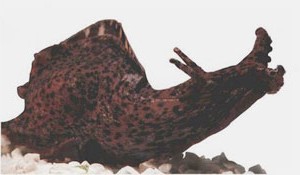|
Media Hotline: 713-500-3030 Scientists
Connect Brain Cell Changes
Researchers at The University of Texas Medical School at Houston describe their findings in the May 31 issue of Science. By pinpointing a neuron that changes when a sea snail learns to bite to earn a reward, the research team opened a new path for analyzing the cellular and molecular processes underlying operant conditioning. “Reward learning is a very big part of everything that we do. When you do something and get a reward for doing it, you change your behavior,” said the paper’s senior author, John H. Byrne, Ph.D., head of the UT-Houston Medical School Department of Neurobiology and Anatomy. Scientists have observed the behavioral aspects of operant conditioning in animals and humans for decades. “The big question is how does it work, what are the underlying processes in the brain?” Byrne said. “We’ve reduced the complex process of reward learning down to the level of a single nerve cell. The promise here is that we can use biochemical and molecular approaches to understand the cellular processes in the neuron that gives rise to changes in behavior.” Byrne and colleagues drew on their extensive knowledge of the marine snail Aplysia to design a project that tracked a learned behavioral change to a change in a single neuron. The project focused on the snails’ feeding habits. Aplysia bite spontaneously in their search for food. A successful bite that secures food sends a reward signal to the brain via a nerve in the animal’s esophagus. The reward signal is absent when the bite comes up empty. By wiring an electrode to this nerve, the scientists mimicked the food reward signal with electrical stimulation. Similar to the virtual reality depicted in the movie The Matrix, they now could “feed” the snails with food that didn’t exist. A group of snails received such a “virtual” food reward every time they bit. One control group got no stimulation, and a second control group received stimulation that was only randomly associated with biting. The rewarded group learned to bite more often than the two control groups, even though there never was any “real” food. In addition, just 10 minutes of training induced a memory that lasted at least a day. Analysis of the brain activity from trained animals pinpointed changes in a specific neuron, known as B51. Activity in B51 has been correlated with the ingestion of food. The changes in B51 following conditioning are such that the cell is more likely to be active. Thus, the animals could be expected to increase their eating responses after conditioning. To eliminate other variables that might have influenced the results, the team then removed the individual cell from the brain, placed it in culture, and conducted an experiment using the neurotransmitter dopamine. Previous research has associated dopamine with the brain’s reward response in a variety of animals, including both snails and humans. Cultured B51 cells changed their electrical properties when they were “rewarded” with a puff of dopamine right after receiving an electrical pulse that mimicked the cell’s activity during the biting behavior. “The B51 neuron changes its properties to allow it to get more dopamine,” Byrne said. “The changes resulting from conditioning the single cell are the same changes found in the B51’s from the trained animals." Dopamine is thought to mediate the rewarding properties of drugs abused by humans. One commonly used animal model in addiction research is to study the brain of rats after they have self-stimulated reward centers in their brains by pressing a lever. Apparently, self-stimulating their brains by biting leads to dopamine-mediated changes in identified Aplysia cells. If the similarities continue on the molecular level, the single-cell approach introduced by Byrne and his colleagues would be a very promising way to study the molecular mechanisms of addiction. Co-lead authors on the paper are postdoctoral researcher Björn Brembs, Ph.D., and Fred D. Lorenzetti, a doctoral student with the Graduate Neuroscience Program in Byrne’s lab. Neuroscience doctoral student Fredy D. Reyes and Douglas Baxter, Ph.D., associate professor in the department of Neurobiology and Anatomy are also co-authors. |


 HOUSTON
— Neuroscientists have identified a brain cell that changes during
operant conditioning, which is a form of reward learning, providing
the first look at cellular processes involved in this major, but
poorly understood, form of learning.
HOUSTON
— Neuroscientists have identified a brain cell that changes during
operant conditioning, which is a form of reward learning, providing
the first look at cellular processes involved in this major, but
poorly understood, form of learning.